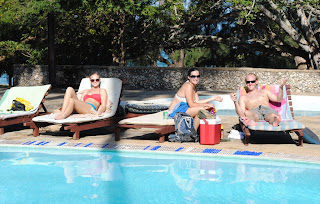A few months ago I was presented with the following question:
"What is the cost to the Kenyan society of NOT providing CARE for AIDS services to a person living with HIV/AIDS?"
After researching online, speaking with other professionals, and gathering data from our staff, I came up with an answer and discovered several interesting facts along the way. This might get a little long, so you can skip to the bottom for the final results if you'd like. If you would like more information on where any of the specific numbers came from, feel free to ask!
First, I tried to determine how many people are directly impacted by a person living with HIV/AIDS in Kenya. The majority of our clients are married, both living with HIV/AIDS. From our records, we found that about
40% are single parents or are part of discordant couples, so for each family represented, we have an average of
1.6 infected parents. Also from the data collected with incoming client groups, we know that our clients have an average of
4 children per family.
Next, we needed to know the life expectancy for a person living with HIV/AIDS in Kenya - both if they were receiving care and if they were not. From several published research projects looking at the life expectancy of HIV-positive adults in various places around Africa, with different sets of extenuating circumstances and various socio-economic situations, it became apparent that the life expectancy for a typical client, without the counseling, education, and assistance provided by CFA, is
2.75 years. This is assuming that the person will not be consuming a healthy diet, will not be properly taking ARV medication, and will not be taking every possible precaution to guard against opportunistic infection. If we are successful in providing care, the client WILL be doing each one of these things, and can thus survive an average of
20 years. This figure is again supported by professional research and is a conservative estimate when the advances in medical care in the coming decades are taken into account.
After that, we considered the opportunistic infections that any HIV+ person will experience. These are diseases like malaria and tuberculosis that prey on the weakened immune system of people living with HIV/AIDS and are often the actual cause of death. Without care and education, most people living with HIV/AIDS are victim to some kind of
infection every 3 months, an average of 4 infections per year. The vast majority of our clients come to us with no health insurance, which means the doctor's visits and medication associated with each infection will cost the client approximately
$60. Because most of the clients are not producing any excess income, this cost must be assumed by relatives, well-wishers, and other members of society. While in the CFA program, clients are put on a proper regimen of medication and are taught about sanitation and preventing opportunistic infections, which lowers their infection rate to about
1 opportunistic infection per year. They are also enrolled in a government-sponsored health insurance scheme for low-income people called NHIF, which lowers the cost of treatment to about
$6 per infection. Over the course of an entire year, the client will pay about
$75 for healthcare.
Then we explored the costs associated with a funeral - a major expense in Kenyan culture. When someone dies, their body must be transported back to their traditional homeland, along with a group of relatives or friends. They must pay for a coffin, burial expenses, and outstanding hospital fees in additional to the cost of transportation. According to a poll among several members of our staff, the average minimum cost for all of this is about
$300. Again, none of our clients have money put aside for these expenses, which means they must be assumed by the people around them. Because we work with our clients to save with credible institutions and budget for the future, though, and because our clients can live long enough to accumulate savings and allow their children to grow to an income-producing stage in life, the cost of a funeral for our clients 20 years down the road will not be imposed upon society.
Another important aspect of this question concerns the children of people living with HIV/AIDS. If an orphan is taken care of in an orphanage in Kenya,
someone will end up paying about
$180 per year. Most children who find their way to an orphanage receive care until the age of 18, so we assume that our clients' children would require an average of
9 years of care each if their parents were to pass away.
Finally, we tried to estimate how many additional infections a person living with HIV/AIDS would be responsible for without the care and education provided by CFA . Through data available online and the anecdotal evidence provided by our staff and others working in the medical arena, we determined that about
80% of people will infect someone else during the course of their life through sexual transmission or caregiving. About
25% of women will give birth to an HIV+ child. With a proper understanding of the virus and of the methods of transmission, though, the reinfection rate falls close to
0%.
After gathering all of these numbers, we were able to group the cost to society for people without care into several components:
- Medical costs - the number of opportunistic infections per year multiplied by the cost of treatment for each infection, multiplied by the number of infected parents and the life expectancy.
- Funeral costs
- Childcare costs - the number of children multiplied by the number of years of care required and the cost of each year of care in an orphanage.
Then, the sum of these components was scaled to reflect the average number of additional infections that each person would be responsible for. Because those people could then infect others, this could lead to a never-ending cycle, but we decided to include only the single iteration that the person we are looking at would be directly responsible for.
This gave us our final number - the cost to society that is saved when each client receives the life transformation and empowerment that CARE for AIDS provides: $16,500.
Obviously this isn't an exact number and there is quite a bit of estimation involved, but the bigger purpose in pointing to this number is to show how much is accomplished for a relatively small investment.
The cost of taking one client through the CARE for AIDS program is only $200. After that, the client will "pay" only around $100 per year for health insurance, medical costs, and savings for funeral expenses.
Because they are providing for themselves and their children, saving for the future, and guarding against opportunistic infections and the spread of the virus, their financial burden on society drops by over sixteen THOUSAND dollars. I find this truly amazing. What a testament to the impact that a small investment from an American Christian can have not only on one family, but on the struggling economy and society of a developing country.


































































